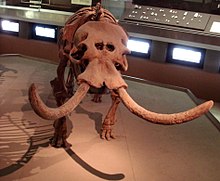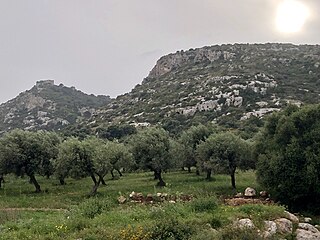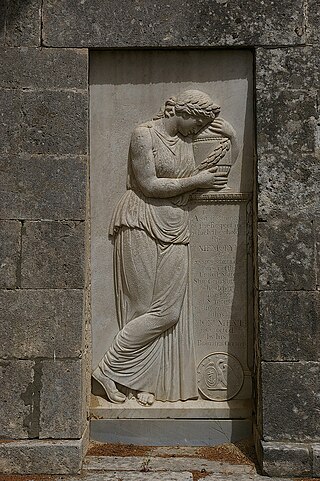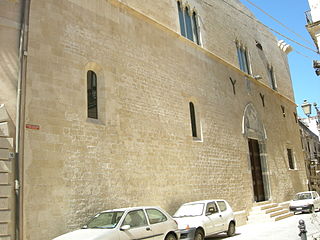Museo archeologico regionale Paolo Orsi | |
 | |
 | |
| Location | Syracuse, Italy |
|---|---|
| Type | archaeology |
| Website | Official website |
The Museo Archeologico Regionale Paolo Orsi of Syracuse, Sicily is one of the principal archaeological museums of Europe.
Museo archeologico regionale Paolo Orsi | |
 | |
 | |
| Location | Syracuse, Italy |
|---|---|
| Type | archaeology |
| Website | Official website |
The Museo Archeologico Regionale Paolo Orsi of Syracuse, Sicily is one of the principal archaeological museums of Europe.
In 1780 the Bishop Alagona inaugurated the Museo del Seminario which became the Museo Civico near the archbishop's house in 1808. Subsequently, a royal decree of 17 June 1878 sanctioned the creation of the Museo Archeologico Nazionale di Siracusa, which was only inaugurated in 1886, in its historic location on the cathedral square. [1]
From 1895 to 1934 Paolo Orsi directed the museum, but the increasing number of finds made a new space necessary at the current location in the garden of the villa Landolina. The new museum space, designed by the architect Franco Minissi was inaugurated in January 1988, with two floors of 9,0002. Initially only one floor and a basement of 3,000 m2 containing an auditorium were open to the public.
In 2006, a new exhibition area on the upper floor was inaugurated, dedicated to the classical period, but more space still remained unused. In 2014 a final expansion allowed the display of the Sarcophagus of Adelphia and other finds from the catacombs of Syracuse.
A free partnership with Google Business Photos and Google Street View Indoor has mapped the entire museum and dozen of its archelogical finds into a Google web platform. Launched online in 2016, it provided the first 360° interactive tour for a cultural institution of the southern Italy. [2] [3]

The museum contains artefacts from the prehistoric, Greek and Roman periods found in archaeological excavations in the city and other sites in Sicily.
The space is divided into four sectors (A – D) and a central space (Area 1) which is dedicated to the history of the museum and briefly overviews the material displayed in the individual sectors.
Sector A is dedicated to the prehistoric (Upper Palaeolithic-Iron Age) with a display of rocks and fossils which testify to the various animals found in Sicily in the Quaternary. It is preceded by a section which displays the geological characteristics of the Mediterranean Sea and the Iblean zone.

In sector B, dedicated to the Greek colonies in Sicily from the Ionic and Doric period, it is possible to see the locations of the Greek colonies in Sicily and their respective mother cities. Also on display:
In sector C there are finds from the colonies of Syracuse: Akrai (664 BC), Kasmenai (644 BC), Camarina (598 BC), Eloro, as well as finds from other centres of eastern Sicily, Gela and Agrigento.

Sector D, located on the upper floor and inaugurated in 2006, contains finds from the Hellenistic and Roman periods. It contains two of the most celebrated pieces in the museum, the Paleo-Christian Sarcophagus of Adelphia and the Venus Anadiomene, also called Venus Landolina after the location of its discovery, found in Syracuse in 1804 and described by Bernabò Brea as "for the excellence of its sculpting, an exquisite treatment of the naked form, of incredibly liveliness and softness". Moreover, a selection of coins from the numismatic cabinet of the piazza Duomo is on display.


Located next to the ancient Villa Landolina, outside the Museum, it is possible to visit the park opposite with finds from the Greek and Roman periods, as well as a non-Catholic cemetery with the tomb of the poet August von Platen.

The Necropolis of Pantalica is a collection of cemeteries with rock-cut chamber tombs in southeast Sicily, Italy. Dating from the 13th to the 7th centuries BC, there was thought to be over 5,000 tombs, although the most recent estimate suggests a figure of just under 4,000. They extend around the flanks of a large promontory located at the junction of the Anapo river with its tributary, the Calcinara, about 23 km (14 mi) northwest of Syracuse. Together with the city of Syracuse, Pantalica was listed as a UNESCO World Heritage Site in 2005.

Hermonax was a Greek vase painter working in the red-figure style. He painted between c. 470 and 440 BC in Athens. Ten vases signed with the phrase "Hermonax has painted it" survive, mainly stamnoi and lekythoi. He is generally a painter of large pots, though some cups survive.

The Museo Nazionale della Magna Grecia, Museo Archeologico Nazionale di Reggio Calabria or Palazzo Piacentini is a museum in Reggio Calabria, southern Italy, housing an archaeological collection from sites in Magna Graecia.

Paolo Orsi was an Italian archaeologist and classicist.

Gino Vinicio Gentili was an Italian archaeologist.

Tleson was an Attic potter and perhaps also a vase painter in the black-figure style. He was the son of the famous potter Nearchos and brother of Ergoteles. His workshop apparently produced mostly Little-master cups. Most of his vases were painted by the Tleson Painter, whose real name is unknown, and whose conventional name is derived from Tleson. Based on the fact that vases known by that hand so far are only ever signed by Tleson, John Beazley suggested that Tleson and the Tleson painter may be identical. There is no proof for this hypothesis. Some of Tleson's pots were painted by other artists, such as Oltos and the Centaur Painter.

The Taleides Painter was an Attic vase painter of the black-figure style, active in the second half of the 6th century BC. His conventional name is derived from his close cooperation with the potter Taleides, many of whose vases he painted. He also worked for the potter Timagoras.

The Antonino Salinas Regional Archeological Museum is a museum in Palermo, Italy. It possesses one of the richest collections of Punic and Ancient Greek art in Italy, as well as many items related to the history of Sicily. Formerly the property of the Oratory of Saint Philip Neri, the museum is named after Antonino Salinas, a famous archaeologist and numismatist from Palermo who had served as its director from 1873 until his death in 1914, upon which he left it his major private collection. It is part of the Olivella monumental complex, which includes the Church of Sant'Ignazio all'Olivella and the adjoining Oratory.

The Necropolis of Cassibile is a large archaeological site in the Province of Syracuse, near the towns of Avola and Cassibile. The site contains a very large graves system situated inside several ravines; the largest of them is called "Cavagrande". About 2,000 graves carved out of the rock have been found; they are dated from the 11th to the 9th century BC. This necropolis gives the name to a precise period of the Sicels' civilization.

The Greek theatre of Syracuse lies on the south slopes of the Temenite hill, overlooking the modern city of Syracuse in southeastern Sicily, Italy. It was first built in the 5th century BC, rebuilt in the 3rd century BC and renovated again in the Roman period. Today, it is a part of the Unesco World Heritage Site of "Syracuse and the Rocky Necropolis of Pantalica".

The Temple of Apollo is one of the most important ancient Greek monuments of Magna Graecia on Ortygia, in front of the Piazza Pancali in Syracuse, Sicily, Italy.



The Cathedral of Syracuse, formally the Cattedrale metropolitana della Natività di Maria Santissima, is an ancient Catholic church in Syracuse, Sicily, the seat of the Catholic Archdiocese of Siracusa. Its structure is originally a Greek doric temple, and for this reason it is included in a UNESCO World Heritage Site designated in 2005.

The non-Catholic cemetery is situated in Syracuse, in the garden of Villa Landolina, now part of the Museo archeologico regionale Paolo Orsi. It was forbidden to bury in holy land non-Catholic people – including Protestants and Jews – as well as people having committed suicide.

Bellomo Palace Regional Gallery is an art museum in Syracuse, Sicily.
Bonna Daix Wescoat is an art historian and Samuel Candler Dobbs Professor of Art History at Emory University. Her work focuses on ancient Greek art and architecture, particularly Archaic and Hellenistic architecture and sculpture.

Vincenzo Mirabella Alagona was an Italian historian, archaeologist and architect, best known for his work Plans of Ancient Syracuse.

The Sarcophagus of Adelphia is an early Christian, circa 340 AD sarcophagus now in the Museo Archeologico Regionale Paolo Orsi in Syracuse, region of Sicily, Italy. The sarcophagus was found in the Rotunda of Adelphia inside the Catacombs of San Giovanni, in Siracusa. The iconography displayed has similarities to the layout of the Dogmatic and Junius Bassus sarcophagi, although the quality of to depictions is simplified.
{{cite journal}}: External link in |via={{cite journal}}: External link in |via=